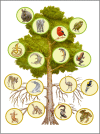Mutilation of the tree of life via mass extinction of animal genera
- PMID: 37722053
- PMCID: PMC10523489
- DOI: 10.1073/pnas.2306987120
Mutilation of the tree of life via mass extinction of animal genera
Abstract
Mass extinctions during the past 500 million y rapidly removed branches from the phylogenetic tree of life and required millions of years for evolution to generate functional replacements for the extinct (EX) organisms. Here we show, by examining 5,400 vertebrate genera (excluding fishes) comprising 34,600 species, that 73 genera became EX since 1500 AD. Beyond any doubt, the human-driven sixth mass extinction is more severe than previously assessed and is rapidly accelerating. The current generic extinction rates are 35 times higher than expected background rates prevailing in the last million years under the absence of human impacts. The genera lost in the last five centuries would have taken some 18,000 y to vanish in the absence of human beings. Current generic extinction rates will likely greatly accelerate in the next few decades due to drivers accompanying the growth and consumption of the human enterprise such as habitat destruction, illegal trade, and climate disruption. If all now-endangered genera were to vanish by 2,100, extinction rates would be 354 (average) or 511 (for mammals) times higher than background rates, meaning that genera lost in three centuries would have taken 106,000 and 153,000 y to become EX in the absence of humans. Such mutilation of the tree of life and the resulting loss of ecosystem services provided by biodiversity to humanity is a serious threat to the stability of civilization. Immediate political, economic, and social efforts of an unprecedented scale are essential if we are to prevent these extinctions and their societal impacts.
Keywords: collapse of civilization; conservation; generic extinction; mutilation tree of life; sixth mass extinction.
Conflict of interest statement
The authors declare no competing interest.
Figures




Similar articles
-
Vertebrates on the brink as indicators of biological annihilation and the sixth mass extinction.Proc Natl Acad Sci U S A. 2020 Jun 16;117(24):13596-13602. doi: 10.1073/pnas.1922686117. Epub 2020 Jun 1. Proc Natl Acad Sci U S A. 2020. PMID: 32482862 Free PMC article.
-
The Sixth Mass Extinction: fact, fiction or speculation?Biol Rev Camb Philos Soc. 2022 Apr;97(2):640-663. doi: 10.1111/brv.12816. Epub 2022 Jan 10. Biol Rev Camb Philos Soc. 2022. PMID: 35014169 Free PMC article. Review.
-
More losers than winners: investigating Anthropocene defaunation through the diversity of population trends.Biol Rev Camb Philos Soc. 2023 Oct;98(5):1732-1748. doi: 10.1111/brv.12974. Epub 2023 May 15. Biol Rev Camb Philos Soc. 2023. PMID: 37189305
-
Mammal diversity will take millions of years to recover from the current biodiversity crisis.Proc Natl Acad Sci U S A. 2018 Oct 30;115(44):11262-11267. doi: 10.1073/pnas.1804906115. Epub 2018 Oct 15. Proc Natl Acad Sci U S A. 2018. PMID: 30322924 Free PMC article.
-
Circling the drain: the extinction crisis and the future of humanity.Philos Trans R Soc Lond B Biol Sci. 2022 Aug 15;377(1857):20210378. doi: 10.1098/rstb.2021.0378. Epub 2022 Jun 27. Philos Trans R Soc Lond B Biol Sci. 2022. PMID: 35757873 Free PMC article. Review.
Cited by
-
Advancing stem cell technologies for conservation of wildlife biodiversity.Development. 2024 Oct 15;151(20):dev203116. doi: 10.1242/dev.203116. Epub 2024 Oct 9. Development. 2024. PMID: 39382939 Free PMC article. Review.
-
The genome sequence of the Violet Carpenter Bee, Xylocopa violacea (Linnaeus, 1785): a hymenopteran species undergoing range expansion.Heredity (Edinb). 2024 Sep 16. doi: 10.1038/s41437-024-00720-2. Online ahead of print. Heredity (Edinb). 2024. PMID: 39278996
-
Modelling reveals the effect of climate and land use change on Madagascar's chameleons fauna.Commun Biol. 2024 Jul 21;7(1):889. doi: 10.1038/s42003-024-06597-5. Commun Biol. 2024. PMID: 39034315 Free PMC article.
-
Predictability of ecological and evolutionary dynamics in a changing world.Proc Biol Sci. 2024 Jul;291(2026):20240980. doi: 10.1098/rspb.2024.0980. Epub 2024 Jul 10. Proc Biol Sci. 2024. PMID: 38981521
-
The role of the plant microbiome for forestry, agriculture and urban greenspace in times of environmental change.Microb Biotechnol. 2024 Jun;17(6):e14482. doi: 10.1111/1751-7915.14482. Microb Biotechnol. 2024. PMID: 38858806 Free PMC article. Review.
References
-
- Steffen W., Broadgate W., Deutsch L., Gaffney O., Ludwig C., The trajectory of the Anthropocene: The great acceleration. Anthropocene Rev. 2, 81–98 (2015).
-
- Dasgupta P., The economics of biodiversity: The Dasgupta review (Hm Treasury, 2021), p. 604.
-
- Rees E. W., The human eco-predicament: Overshoot and the population conundrum. Vienna Yearbook Popul. Res. 21, 1–19 (2023).
-
- Ceballos G., Ehrlich A. H., Ehrlich P. R., The Annihilation of Nature: Human Extinction of Birds and Mammals (Johns Hopkins University Press, Oceano, 2015a), p. 204.
MeSH terms
LinkOut - more resources
Full Text Sources
Miscellaneous


